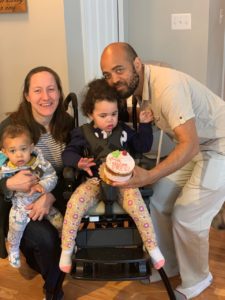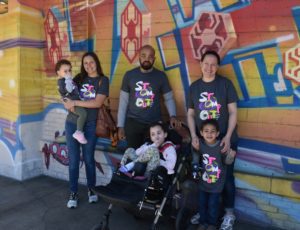A year after her daughter Havilah was diagnosed with CDKL5 deficiency disorder (CDD), Whitney Mitchell’s pediatrician looked her in the eyes and said something that Whitney still carries with her years later:
It’s a marathon, not a sprint.
The phrase, though seemingly simple, was actually a catalyst for a new way of thinking. As the parent of a child with severe medical needs, Whitney often felt an overwhelming pressure to push for every opportunity all at once—signing up for every new therapy, intervention, treatment—reaching for the next milestone or accomplishment.
“Too much therapy isn’t good for anyone. Too much of anything isn’t good for anyone! I’ve come to realize there is a balance. We will keep fighting and pushing, but not at the detriment of losing sight of what’s truly important, and that’s Havilah. I want to be sure I am spending time with her and enjoying who she is the way she is. This is our forever journey; it’s not something that can be ‘fixed’ overnight regardless of how much we try.”
To Whitney, spending time with and supporting her daughter is the most important part of this journey; raising awareness and education follows. She believes that the best way to garner support for the CDD community is through getting people to know about CDD, its impacts, and those affected. Through this, she can find change. That’s one of the reasons why Whitney is so passionate about sharing her and Havilah’s story.

Recently, Whitney spoke with Patient Worthy about the diagnostic journey, what CDKL5 deficiency disorder is, care and management, and advice for families beginning their own journey.
Whitney and Havilah’s Story
Whitney and her husband were so excited to welcome their daughter Havilah into their life. When Havilah was born, the doctors—and her parents—felt as though she was completely healthy. And for the first few months of her life, this belief remained. But when Havilah was three months old, sleeping in between her parents, Whitney and her husband woke up to find the bed shaking. Whitney shares:
“Havilah was having a seizure. We called 9-1-1 and spent the next several days in the hospital. There, Havilah started having tonic clonic seizures, which are intense seizures with extreme muscle spasms that can temporarily keep her from breathing while she’s asleep. We also noticed her eyes deviating one way or another, but the doctors dismissed our concerns. We spent the next 14 months in what felt like a nightmare we couldn’t wake up from.”
Within those fourteen months, Whitney and her husband brought Havilah to doctor after doctor, trying to find somebody who would listen to them and take their situation seriously.
Pursuing a Diagnosis
Some doctors told Whitney that Havilah would grow out of it, that she would eventually stop having seizures or the seizures would slow. Others offered treatment options but balked whenever the parents tried to get involved. Whitney explains:
“Many of the doctors we took Havilah to see in the beginning acted like they had all the answers, and we shouldn’t question them because they were the experts. They kept saying that if I just put Havilah on this one drug or tried this one therapy that it would get her through. They acted like we didn’t really have a choice, but I realized that we did. I could find a new doctor who was willing to learn about this with me.”
At one point, Havilah was experiencing hundreds of seizures each day. Whitney says:
“It was very scary and traumatic. I would never want to go back and live through that again and I wouldn’t wish it on anybody. But throughout this, I kept one thing in mind: that I would never give up on searching for an answer and fighting for my daughter. I talked to everyone about Havilah, even at the grocery store, which is how I found the pediatrician we are still with today.”
During a visit, the new medical team recommended that Havilah undergo genetic testing. One month later, the family finally received a diagnosis: CDKL5 deficiency disorder.
What is CDKL5 Deficiency Disorder (CDD)?
CDKL5 deficiency disorder is a rare developmental epileptic encephalopathy which can cause seizures and developmental delays. As the name suggests, CDD results from CDKL5 gene mutations. Normally, this gene plays a role in creating a type of protein needed for normal brain function and development. But due to the genetic mutations, Whitney explains:
“The body has a deficiency of this particular protein, keeping the brain from functioning at a typical capacity. However, to me, having a daughter living with CDD for the past five years, this disorder goes beyond the medical definition. The first word that comes to mind when I think of CDKL5 deficiency disorder is ‘trapped.’ I feel like Havilah is trapped in her body and in a brain that isn’t functioning the way it should be. She is so limited by her impairments, and as her caregivers, so are we. Watching your child suffer is extremely traumatic.”
CDKL5 deficiency disorder is inherited in an X-linked dominant pattern. Because the mutations can occur early in embryonic development, CDD can occur in those with no family history of this condition.

CDKL5 Symptoms
Symptoms and characteristics of CDKL5 deficiency disorder can include:
- Severe developmental delays
- Speech and language impairments
- Delayed gross and fine motor skills
- Seizures that can begin within 1 week to 3 months after birth
- Note: These seizures can occur daily and are often treatment-resistant.
- Sleep disruptions
- Irregular breathing
- Teeth grinding
- Repetitive hand movements such as clapping, hand licking, flapping, etc.
- Limited ability to walk
- Feeding difficulties
- Constipation
- Gastroesophageal reflux
- Hypotonia (low muscle tone)
- Scoliosis
Receiving the Diagnosis
As many people within the rare disease community know, receiving a diagnosis can be bittersweet. On one hand, you finally have the name of what you’re dealing with; on the other, you may still face a lack of knowledge or understanding about managing the condition. For Whitney, the diagnosis came with a wave of emotion.
“In some ways, I felt this sudden sense of relief because now we had answers and a community to connect to. We weren’t alone anymore. It was the beginning of our new journey, and a weight was lifted. The pediatrician that initially diagnosed Havilah admitted that CDD was a rare disease that she knew nothing about, so we set out to learn about it together.”
In the beginning, it was especially difficult to deal with. Whitney felt as though she needed to learn ten new things every day just to keep up with what quickly became their “new normal.” She says:
“I feel like I know more about the human brain than I ever wanted or needed to! But still, there is so much more to learn. When you have a child with a rare disease or complex medical situation, it never ends. As Havilah grows and changes, her needs change; there’s always new technology, equipment or treatments to consider. A lot of times, I don’t even know the right questions to ask, but I’ll never stop looking for the answers—whether that’s through the internet, our care team or the CDD community.”
Join us in Part 2 as we discuss finding support through the CDD community, care and management, and Whitney’s advice for those just beginning their journey.


